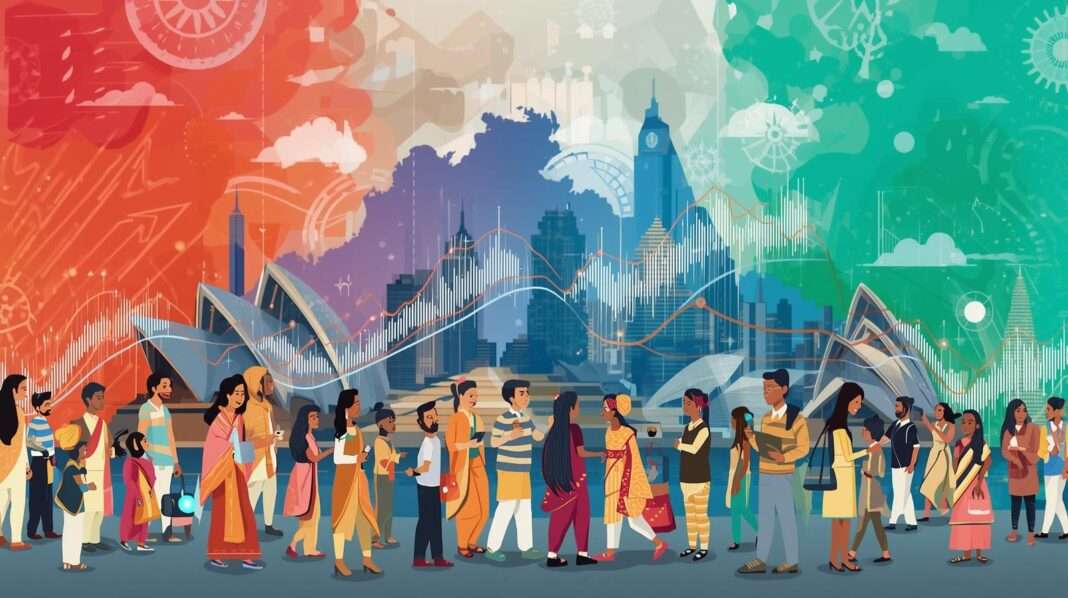Introduction
Australia is one of the world’s most migrant-intensive economies. Except the native original inhabitants, the Aboriginal and Torres Strait Islander peoples, those that have come to this blessed land right from the Europeans are all migrants. As of 30 June 2024, 31.5% of Australia’s estimated resident population—about 8.6 million people—were born overseas (ABS, 2025). The large migrant share underscores how immigration shapes Australia’s workforce, fiscal balance, and long-run growth potential. The influence of migration spans both monetary channels (GDP, fiscal flows, productivity) and non-monetary channels (innovation, social capital, demographic balance). However, recently in Australia major controversy has erupted beginning late 2024 and intensified throughout 2025. This seemingly involves new migration laws and voices for restricting uncontrolled migration to protect Australian jobs and locals. However, it has raised concerns among specific communities, since speeches and social media posts went viral especially targeting the Indian diaspora. Let us examine how the migrants, especially Indian migrants, have an impact on Australian economy.
Monetary (Quantitative) Impacts
Growth, Workforce Supply, and Productivity
Migration expands the economy via the “three Ps”: population, participation, and productivity. New migrants are disproportionately of working age, which immediately supplements the workforce and potential GDP. The Australian Treasury’s modelling emphasises that migrants in the core age bracket (e.g. 25–35) have especially strong lifetime fiscal outcomes (Varela et al., 2021; see also Population.gov.au, 2024). Beyond scale, migration fosters better skill matching, competition, and knowledge diffusion, which can lift average productivity. For example, OECD research suggests that a 10% larger migrant share in a region is associated with about 1.3% higher wage differentials (used as a proxy for productivity) due to spillover effects (OECD, as cited in Population.gov.au, 2024). Immigrants have contributed significantly to Australia’s GDP, with studies projecting an addition of up to $1.6 trillion by 2050 due to migration (AREEA, n.d.) (OECD, n.d.).
Fiscal Impacts: Lifetime Contributions and Costs
To assess direct fiscal impacts, the Australian Treasury developed the Fiscal Impact of New Australians (FIONA) model, which estimates tax revenues and public spending attributable to permanent migrants over their remaining lifetimes (Treasury, 2021). The model finds that the 2018–19 permanent migrant cohort is net fiscal positive overall, both for the Commonwealth and state/territory levels (Treasury, 2021; Treasury, n.d.). In that cohort, migrants in the Skill stream generate the largest net benefit, with Family and Humanitarian streams producing smaller but still positive contributions (Treasury, 2021; Varela et al., 2021). The FIONA analysis suggests that the average lifetime fiscal impact of a permanent migrant (compared to average Australian population) is around AUD 41,000 (for the 2018–19 cohort) (Department of Education, 2020). However, within the Skill stream, the lifetime benefit per migrant is estimated much higher—on the order of AUD 198,000 (Department of Education, 2020). Migrants pay more in taxes over their lifetimes than they receive in government benefits, contributing net fiscal surpluses that enhance public finances and support higher consumption and economic growth (AMP, n.d.).
Export Earnings and Spillover Demand
Temporary migration, especially international students, makes a major contribution to Australia’s export earnings. In 2023–24, international education was valued at approximately AUD 51.0 billion, combining tuition and student-related consumption (Education Department, n.d.; RBA, 2025). This has broader multiplier effects, it adds directly to GDP, stimulates demand in accommodation, transport, and services.
Per Capita Effects and Risks
While immigration almost certainly increases aggregate GDP, the effect on GDP per capita is more conditional. The Productivity Commission (PC) argues that per capita gains depend heavily on the skill level, age, and assimilation of migrants (Productivity Commission, 2023). If migration is poorly aligned (e.g. older, low-skill entrants), the gains may be diluted or offset by congestion and infrastructure pressures.
Non-Monetary (Qualitative) Benefits
Innovation, Entrepreneurship, and Knowledge Spillovers
Migrants often bring diverse backgrounds, skills, and global networks that can stimulate innovation. Empirical studies show migrant presence is associated with increased patenting, firm formation, and export orientation (OECD, as discussed in Population.gov.au, 2024). Firms tapping into multicultural human capital often gain competitive edges in international markets. Highly educated migrants contribute substantially to Australia’s skills base, particularly through skilled visa programs that address workforce shortages (AMP, n.d.).
Demographic Renewal and Ageing Pressure Mitigation
Australia faces an ageing population and rising dependency ratios. Immigration helps slow ageing by increasing the share of working-age residents and boosting birth rates (IGR, 2023). Migrants tend to be younger and more educated than the average Australian, with over half of permanent migrants holding a bachelor’s degree or higher, compared to about 29% for the broader population (AMP, n.d.). Treasury’s Long-Term Projections rely on stable migration flows to maintain workforce supply and public finances over coming decades.
Social Capital, Networks, and International Linkages
Beyond numbers, migrants contribute intangible benefits: diaspora networks, cultural diversity, and global connections that reduce transaction costs in trade and investment. International students who stay become bridges in business, research, and alumni relationships, strengthening Australia’s soft power and global engagement.
Challenges, Trade-offs, and Contextual Constraints
Housing, Infrastructure, and Congestion Pressures
One of the most visible short-run effects of migration is increased pressure on housing supply and rental markets. With migration surging post-pandemic, rent inflation and urban congestion have intensified. If housing and infrastructure do not keep pace, these costs can offset parts of the migration gain (ABS, 2025; PC, 2023).
Local Wage and Workforce Market Effects
Concerns that migrants depress wages or displace native workers are often overstated. One analysis suggests modest average impacts, with effects concentrated in certain localities or skill overlaps (PC, 2023). Migration tends to complement, not substitute, in many sectors since migrants filling skill gaps enabling local firms to expand.
Policy Dependence of Outcomes
The realized benefits of migration hinge heavily on policy complements: effective integration, recognition of foreign credentials, infrastructure planning, and matched regional incentives. Without those, the risks of underemployment, skills mismatch, or spatial concentration increase (PC, 2023).
Australian Hindus and Indian Diaspora
Demographic and Economic Impact
- Hindu migrants have contributed significantly to Australia’s society, economy, and cultural landscape, making Hinduism the fastest-growing religion in the country and shaping a more diverse and vibrant nation. The Indian diaspora in Australia, of which majority are Hindu migrants, has expanded rapidly since 2006, with a 3.7-fold increase in numbers (IMEAD, n.d.)(Excelsior, n.d.) (UQ, n.d.).
- Most migrants are young (aged 25-44), highly educated, and have strong employment rates, with 85.3% of Indian-born migrants working—higher than the general migrant population (IMEAD, n.d.)(Excelsior, n.d.) (UQ, n.d.).
- Indian immigrants, including Hindus, play crucial roles in essential sectors and entrepreneurship, boosting innovation and filling workforce gaps, in capital cities and increasingly in regional areas (IMEAD, n.d.)(Excelsior, n.d.) (UQ, n.d.).
- Their presence strengthens ties between Australia and India through commerce, education, and cultural exchange (IMEAD, n.d.)(Excelsior, n.d.) (UQ, n.d.).
- Indian-born migrants also boast a high employment rate of 85.3%, surpassing the overall migrant average thus making a significant contribution to community building in Australia (News, n.d.).
Social and Cultural Influence
- Hindu migrants have introduced their rich traditions, festivals, and cuisine. Diwali, Holi, and Ratha Yatra are now part of mainstream Australian celebrations. Hindu temples and cultural organizations foster community engagement and intercultural understanding, emphasizing diversity and tolerance.
- Yoga, with roots in Hindu spirituality, has become more popular than tennis, golf, or soccer among Australians.
Indian Community Initiatives
- The Indian Support Centre provides essential services in education, cultural preservation, and crisis response, funded by community donations. Government funding, such as up to $2.4 million for Indian Community Centres in Victoria, enables culturally appropriate spaces for local organizations to foster integration and support (Premier, n.d.).
- Indians have shaped Australia’s healthcare and community support systems, with notable advocacy for migrants, women, and people with disabilities. For example, individuals like Menaka Iyengar have been recognized for decades of inclusion work (Amit, n.d.).
- A government report highlights the Indian diaspora’s role in social development, including volunteering and civic contributions (DFAT, n.d.).
Hindu specific Charitable Efforts
- Sewa Diwali and Food Drives: This nationwide initiative, led by Hindu groups, collects food and donations for those in need, embodying compassion and unity. In 2024, volunteers gathered over 27,700 kg of food with 94 partner organizations; such efforts recently recognized in Parliament (Today, n.d.).
- Benevolent Funds and Volunteering: The Hindu Council of Australia’s Hindu Benevolent Fund offers financial aid to families in crisis, alongside programs like the Diwali Fair and International Yoga Day events (HCA, n.d.). The Vaishnav Sangh of Sydney organizes blood donation drives, volunteering, and local charities. BAPS Charities, established in 2019, coordinates volunteer-led support for individuals and communities across Australia (BAPS, n.d.).
Challenges and Community Resilience
- Despite their contributions, Hindu and Indian Australians face discrimination, workplace exclusion, and occasional vandalism targeting temples, reflecting persistent societal challenges (HCA, n.d.) (ABC, n.d.).
- Community organizations and advocacy groups actively work to counter stereotypes and build safer, more inclusive environments.
- Maintaining connections with India while integrating into Australian society has been a hallmark of Hindu migrants, thus enriching both nations’ ties.

Conclusion
The evidence strongly supports the proposition that immigration has been net beneficial to the Australian economy, both in monetary terms (higher output, positive fiscal contributions, export growth) and non-monetary terms (innovation, demographic balance, social capital). Migrants, especially Indians and Hindus, have a substantial positive impact on Australia’s economy, contributing to GDP growth, workforce participation, innovation, and overall productivity. Their presence not only boosts demand and supply in key economic sectors but also drives regional and national prosperity through entrepreneurship and a highly educated workforce. While challenges—particularly housing, infrastructure, and short-term congestion—cannot be ignored, they are not a reason to scale back migration but rather to improve supporting policies. Well-designed, skills-based migration aligned with planning, integration, and infrastructure can ensure the dual benefits of growth and shared prosperity.
References
- Australian Bureau of Statistics. (2025). 9 facts about Australia’s overseas-born population. ABS. https://www.abs.gov.au/media-centre/media-releases/9-facts-about-australias-overseas-born-population
- Department of Education. (2020). Submission to Migration Review: lifetime fiscal impact of permanent migrants. https://www.homeaffairs.gov.au/reports-andpubs/files/migration-system-aust-future-submissions/af/Australian_Government_Department_of_Education.pdf
- Population.gov.au. (2024). Determinants of the economic outcomes of Australian permanent migrants.
https://population.gov.au/sites/population.gov.au/files/2024-07/determinantsoutcomes-permanent-migrants.pdf - Productivity Commission. (2023). Migrant intake: report overview.
https://www.pc.gov.au/inquiries/completed/migrant-intake/report/migrantintake-report-overview.pdf - Treasury. (2021). The lifetime fiscal impact of the Australian permanent migration program (FIONA). https://treasury.gov.au/publication/p2021-220773
- Varela, V., et al. (2021). The lifetime fiscal impact of new Australians: methodological framework. In The lifetime fiscal impact of the Australian permanent migration program. (See Treasury, 2021)
- AMP. (n.d.). Retrieved from https://www.amp.com.au/resources/insights-hub/the-economics-of-immigration-in-australia
- AREEA. (n.d.). Retrieved from areea.com.au: https://www.areea.com.au/news-media/media-center/migration-contribute-1-6-trillion-gdp-2050/
- OECD. (n.d.). OECD: Findings on the effects of migration on Australia’s economy. Retrieved from https://population.gov.au/publications/research/oecd-findings-effects-migration-australias-economy
- ABC. (n.d.). Retrieved from https://www.abc.net.au/news/2025-09-12/indianaustralian-community-feel-targeted-after-anti-immigration/105751878
- IMEAD. (n.d.). Retrieved from https://imeadvisors.com/blog-detail/indians-leadaustralias-immigration-despite-post-pandemic-decline-in-net-migration
- UQ. (n.d.). Retrieved from https://news.uq.edu.au/2025-08-rich-and-growing-history-indian-migrants-australia
- BAPS. (n.d.). Retrieved from https://www.bapscharities.org/australia/
- DFAT (n.d.). Retrieved from https://www.dfat.gov.au/sites/default/files/australias_indian_diaspora_220317_full_report.pdf
- HCA (n.d.). Retrieved from https://hinducouncil.com.au/hindu-benevolent-fund/
- Premier, V. (n.d.). Retrieved from https://www.premier.vic.gov.au/more-funding-support-indian-community-connection
- Today, T. A. (n.d.). Retrieved from https://www.theaustraliatoday.com.au/australian-hindus-lead-nationwide-food-and-donations-drive-for-compassion-and-unity-through-sewa-diwali/




